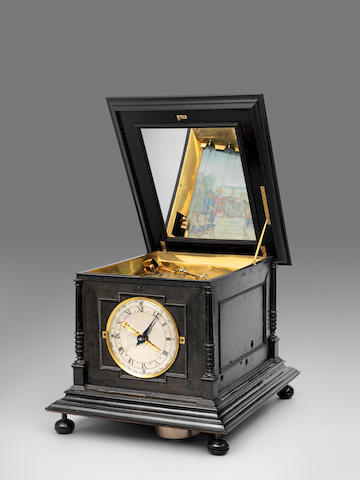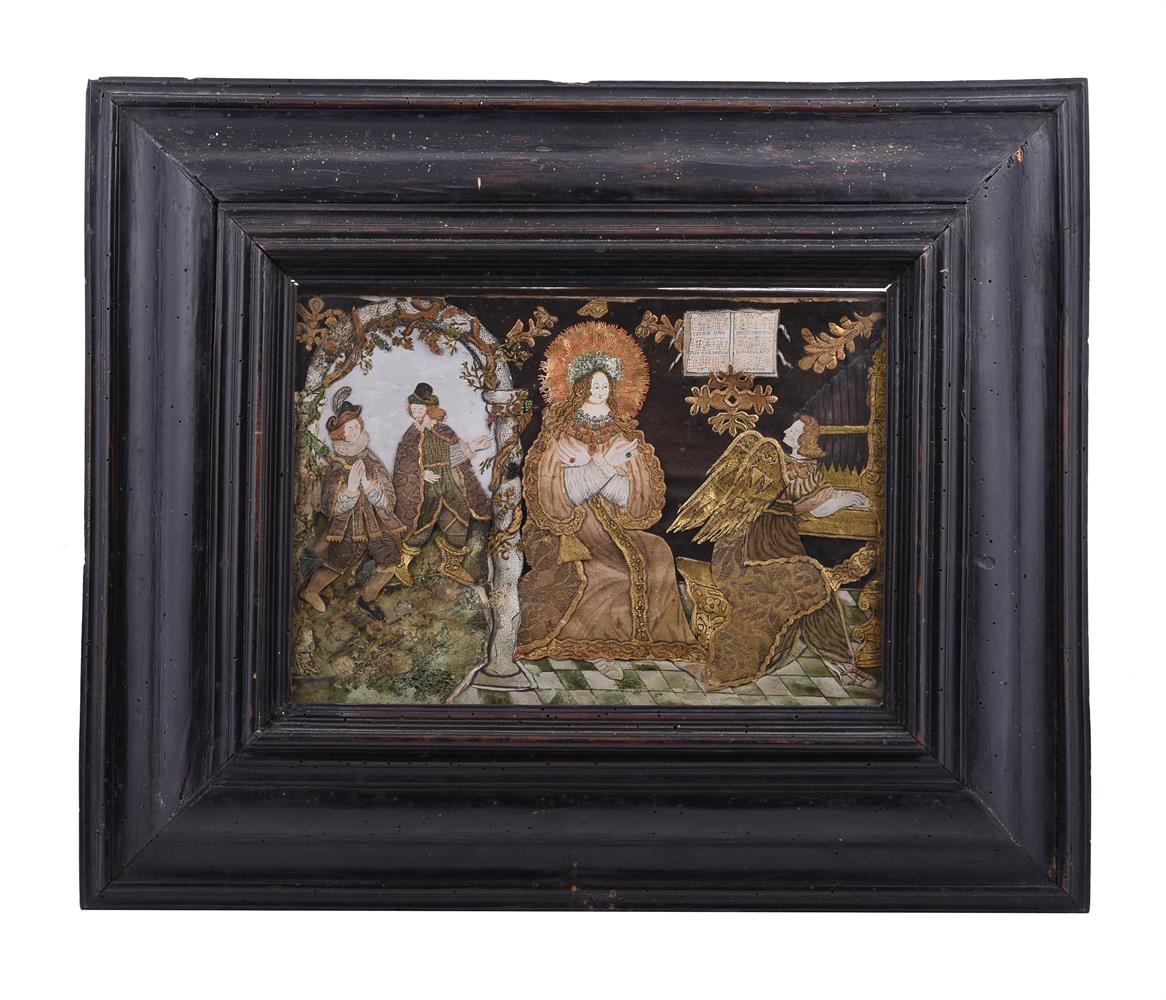A rare early 17th-Century English gilt-brass pocket astronomical compendium ( incomplete ), signed R. Grinkin Fecit , undated , The instrument is constructed in eight sections, comprising from the top: a) wind rose b) table of latitudes of twenty-five towns c) equinoctial sundial d) compartment to hold compass ( missing ) e) shallow compartment f) underside of nocturnal g) rim a) The wind rose is engraved on the outer domed surface, where the gilding is rubbed through use. The thirty-two winds are named on ribbons, the same pattern being first noticed on a chart engraved by Augustine Ryther of 1592; it appears again on a compass dial by Charles Whitwell of c.1600, on a compendium by Whitwell of 1606, and on three compendia by Elias Allen of c.1610. At the centre of the rose is a small hole, dia. 0.8mm, that is most likely to have been for inserting a wind vane. b) Inside the top plate is a table of five columns and five rows listing the latitudes of twenty-five towns in degrees and minutes. The table is titled in a central circle THE names of tounes and cityes in Europe . The values of latitudes do not match exactly those found on similar compendia. It seems that the maker rounded the values for minutes of arc, generally to tens, but to 15' in four cases and 56' in one. The gold plating is perfect. Table of Latitudes London 51 30 Franckford 50 10 Barcelon 43 15 Yorke 54 0 Heydelberg 49 30 Bayon 44 30 Barwick 56 0 Augusta 48 15 Lions 45 15 Edenbro 57 0 Basill 47 50 Roan 49 30 Lincoln 53 0 Buda 46 50 paris 48 40 Neaples 40 40 Antwerpe 51 30 Florence 42 40 Louain 50 56 Verona 44 15 Lisbon 39 0 Venice 45 0 Toledo 37 0 Roma 42 0 granad 35 0 c) The equinoctial dial is the same as those made by Whitwell and Allen. The gnomon is set by a quadrant divided from 0 to 90° in two degree intervals, labelled every 10°. The dial is set at the correct angle by running the edge of the quadrant through a slot in the vertical mounting past a pair of knife-edges against which is set the appropriate degree of latitude. The plummet is missing. The chapter ring on the upper (summer) side is divided in half hours I-XII (x2). The under (winter) side is divided in half hours alternately shaded (unlike the upper side) VI-VI . The signature is engraved on this side. The act of lifting the top plate automatically raises the equinoctial dial to the vertical, by means of a lug protruding from the central part of the hinge. d) There follows an oval compartment, 9mm deep, that has a plain ungilded base, originally intended to hold a magnetic compass ( missing ) for orienting the dial. e) On the other side of this compartment is another that is very shallow, 3mm deep, also with a plain ungilded surface. f) The final part of the instrument is a nocturnal, the underside of which shows the four attachment grips on the sighting volvelle. The surrounding surface is engraved with a scoop decoration. g) Much of the surface gilding of the nocturnal has worn away. The outermost circle is engraved with the days of the month in two-day intervals, labelled in tens (or 28, 31). There follow the names of the months: Ianuari, Februari, March, Aprill, Maye, Iune, Iulie, August, September, October, Nouembe, Decembe . There follow two volvelles, the outer with a 24-hour circle, marked out as twice 12, the hours divided in halves, alternately shaded. The edge is cut with a 'saw' tooth at each hour, with a longer index at one 12 o'clock position. The inner volvelle is cut with a slit from the centre to the edge for viewing the Pole Star and the Lesser Bear. The earliest known use of this slit form of nocturnal is on a compendium dated 1590 by Humfrey Cole. At the edge in line with the slit is an index for pointing to the time on the previous volvelle. At either end, the oval surface is engraved with a foliate decoration h) The rim is inscribed with an acanthus motif. The extension holding the suspension ring is small. Closure of the top and bottom plates is by snap
A rare early 17th-Century English gilt-brass pocket astronomical compendium ( incomplete ), signed R. Grinkin Fecit , undated , The instrument is constructed in eight sections, comprising from the top: a) wind rose b) table of latitudes of twenty-five towns c) equinoctial sundial d) compartment to hold compass ( missing ) e) shallow compartment f) underside of nocturnal g) rim a) The wind rose is engraved on the outer domed surface, where the gilding is rubbed through use. The thirty-two winds are named on ribbons, the same pattern being first noticed on a chart engraved by Augustine Ryther of 1592; it appears again on a compass dial by Charles Whitwell of c.1600, on a compendium by Whitwell of 1606, and on three compendia by Elias Allen of c.1610. At the centre of the rose is a small hole, dia. 0.8mm, that is most likely to have been for inserting a wind vane. b) Inside the top plate is a table of five columns and five rows listing the latitudes of twenty-five towns in degrees and minutes. The table is titled in a central circle THE names of tounes and cityes in Europe . The values of latitudes do not match exactly those found on similar compendia. It seems that the maker rounded the values for minutes of arc, generally to tens, but to 15' in four cases and 56' in one. The gold plating is perfect. Table of Latitudes London 51 30 Franckford 50 10 Barcelon 43 15 Yorke 54 0 Heydelberg 49 30 Bayon 44 30 Barwick 56 0 Augusta 48 15 Lions 45 15 Edenbro 57 0 Basill 47 50 Roan 49 30 Lincoln 53 0 Buda 46 50 paris 48 40 Neaples 40 40 Antwerpe 51 30 Florence 42 40 Louain 50 56 Verona 44 15 Lisbon 39 0 Venice 45 0 Toledo 37 0 Roma 42 0 granad 35 0 c) The equinoctial dial is the same as those made by Whitwell and Allen. The gnomon is set by a quadrant divided from 0 to 90° in two degree intervals, labelled every 10°. The dial is set at the correct angle by running the edge of the quadrant through a slot in the vertical mounting past a pair of knife-edges against which is set the appropriate degree of latitude. The plummet is missing. The chapter ring on the upper (summer) side is divided in half hours I-XII (x2). The under (winter) side is divided in half hours alternately shaded (unlike the upper side) VI-VI . The signature is engraved on this side. The act of lifting the top plate automatically raises the equinoctial dial to the vertical, by means of a lug protruding from the central part of the hinge. d) There follows an oval compartment, 9mm deep, that has a plain ungilded base, originally intended to hold a magnetic compass ( missing ) for orienting the dial. e) On the other side of this compartment is another that is very shallow, 3mm deep, also with a plain ungilded surface. f) The final part of the instrument is a nocturnal, the underside of which shows the four attachment grips on the sighting volvelle. The surrounding surface is engraved with a scoop decoration. g) Much of the surface gilding of the nocturnal has worn away. The outermost circle is engraved with the days of the month in two-day intervals, labelled in tens (or 28, 31). There follow the names of the months: Ianuari, Februari, March, Aprill, Maye, Iune, Iulie, August, September, October, Nouembe, Decembe . There follow two volvelles, the outer with a 24-hour circle, marked out as twice 12, the hours divided in halves, alternately shaded. The edge is cut with a 'saw' tooth at each hour, with a longer index at one 12 o'clock position. The inner volvelle is cut with a slit from the centre to the edge for viewing the Pole Star and the Lesser Bear. The earliest known use of this slit form of nocturnal is on a compendium dated 1590 by Humfrey Cole. At the edge in line with the slit is an index for pointing to the time on the previous volvelle. At either end, the oval surface is engraved with a foliate decoration h) The rim is inscribed with an acanthus motif. The extension holding the suspension ring is small. Closure of the top and bottom plates is by snap















Testen Sie LotSearch und seine Premium-Features 7 Tage - ohne Kosten!
Lassen Sie sich automatisch über neue Objekte in kommenden Auktionen benachrichtigen.
Suchauftrag anlegen